Bullet bras today are a symbol of the 1950s. With the suggestive silhouette they lend, these pointy bras became iconic. However, such provocative undergarments also flew in the face of the wholesome good girl persona that really was the norm more often than not back then. So, how did these cones bras ever become so popular?
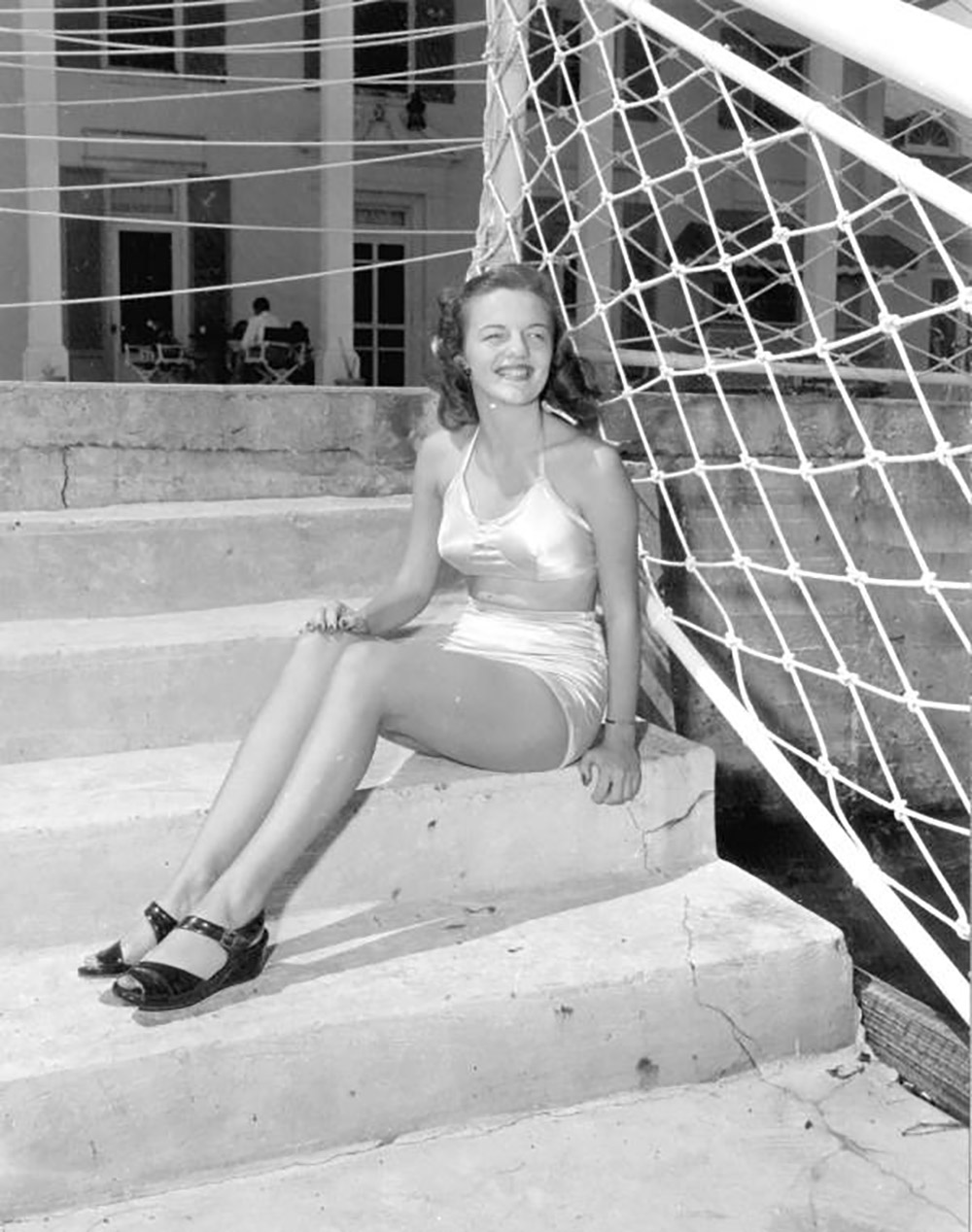
The first brassieres date back to the 1910s and 1920s, although they would not become wardrobe staples for women until after the slinky (and very feminine) bias-cut gowns of the 1930s finally pushed corsets out of popularity. This trend gave rise to both the bra and the supportive slip.
In previous eras both the the bra and the slip would have provided modesty and warmth, but did little to shape or support the chest.

The first bullet bra was released in 1941 under the Perma-Lift brand. Ads for the new style of bras captivated customers with promises of supreme comfort and support all in one. The Perma-Lift was made without underwires- only stitching forced the cups to keep their shape.
The shape of the bra cups were conical, but since it was wartime, the terms “bullet bra” and “torpedo bra” both stuck around. Just like the new hairstyle was called Victory rolls, so the newest bra was given a name that reflected the times.
The 1940s was a decade torn apart by World War II, but the war also gave rise to a whole new culture of glamor. As had been the case in the 1930s when folks were seeking solace from the woes of the Great Depression by going to the movies, films were highly influential in the 1940s as well.

The Wilde Twins as pin-ups in a 1945 issue of Yank magazine. Via/ Wiki Commons
Famous actresses and models also became pin-up girls, something which was considered a helpful to boost the morale of the millions of American men sent to fight in the Pacific and European theaters of war.
When actresses began to wear the new cone bras, the trend became very popular as everyday women wanted to emulate the stars in all their glory. But, there was a downside to having such pointy breasts. Some people did find the trend to wearing tight sweaters and accentuated bustlines to be a sign of the decaying morality of the post-war era. However, the term “sweater girls” had actually been christened in 1937 for Lana Turner for her role in the film, They Won’t Forget. In that movie Turner wasn’t wearing a bullet bra, but she was wearing a very tight sweater.

Singer, Patti Page, 1955. Via/ Wiki Commons
Soon starlets were wearing bullet bras and tight sweaters in combination, which only cemented the sweater girl in popular culture. Regardless of the bad reputation of the sweater girl, the bullet bra had made its way into the dressers of most young women.

Via/ State Archives of Florida
With the rise in plastics and synthetic fibers in the early 20th century, it was only a matter of time before those novel materials were applied to bras to make them more elastic and supportive at the same time.
By the 1950s the shape of many bullets bras had become extremely exaggerated, which necessitated pads (or falsies) to keep the cone cups from looking deflated when being worn.
Well into the 1960s the bullet bra was still going strong, as was the original Perma-Lift. However, by the late 1960s and early 1970s a more natural silhouette had come into fashion and soft cup bras were selling more readily (and they were more comfortable, too).
Madonna brought the bullet bra back into popular culture with the Jean Paul Gaultier-designed costumes she wore for her Blonde Ambition tour in 1990.
There a few old school makers of bullet bras still churning out these bras today. There is a whole new crop of cone bra makers for people who love vintage silhouettes, although this is admittedly a niche market in the post-Wonderbra era.

Kim Novak in 1962. Via/ Nationaal Archeif
Whether you loved or hated cone bras, there’s no denying that they are a huge part of fashion history, one we’re not likely to forget anytime soon thanks to the likes of actresses like Lana Turner, Marilyn Monroe, and Kim Novak.
History of The Bullet Bra – Sweater Girl Society
If it weren’t for bullet bras, there would never had been “Sweater Girls!” The bullet bra gave America’s “Sweater Girls” that timeless, unforgetable, distinctive silhouette that forever shaped 1950s fashion and culture.
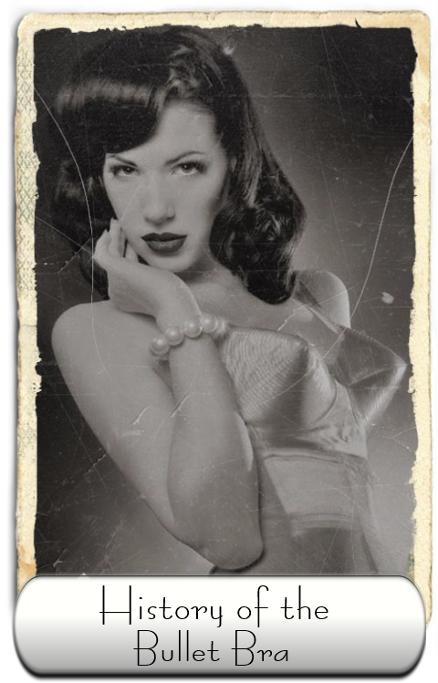
Prior to the 1940s, bras had very little to do with fashion, and more to do with simply keeping a woman’s breasts suppressed and out of the way. In fact, ladies undergarments, at the time, actually worked to de-emphasized a woman’s bust line, as apposed to emphasizing it. A perfect example of this was with the “Flapper Girl” look that became popular during the roaring ’20s. The “Flapper Girls” adopted a boyish look to their physique which included having a straight waistline, and bounding their breasts to give them a more flat-chested look.
By the time the 1940s was ushered in, the flat-chested look of the “Flapper Girls” had long faded out, and America was about to witness a new fashion trend that would soon put the emphases on giving women a more defining look to their bust line.
While Hollywood director and business tycoon, Howard Hughes, was filming his new movie, The Outlaw, he was unsatisfied with how Jayne Russell’s breasts appeared in the movie. This lead Hughes to design his own bra for Russell to wear in the movie the Cantilever Bra. Hughes’ cantilever bra became the pre-cursor to the overly-emphasized “Bullet-Bra” which would eventually be introduced a few years later. When The Outlaw was released in 1943, Russell’s appearance in the movie, with her overly-emphasized bust line, set the nation, along with the Hollywood movie censors, on fire.
In the mid-1940s Frederic Mellinger opened a shop called “Frederick’s of Hollywood,” located on Hollywood Boulevard in Las Angeles. Through his shop, Mellinger introduced black lingerie into the United States, and created the world’s first push-up bra.
Mellinger spread the idea that lingerie served the purpose of making a woman feel right in her body, a very modern idea indeed. Hollywood stars immediately started shopping in Frederic’s shop, and eventually “normal” women would shop there as well.
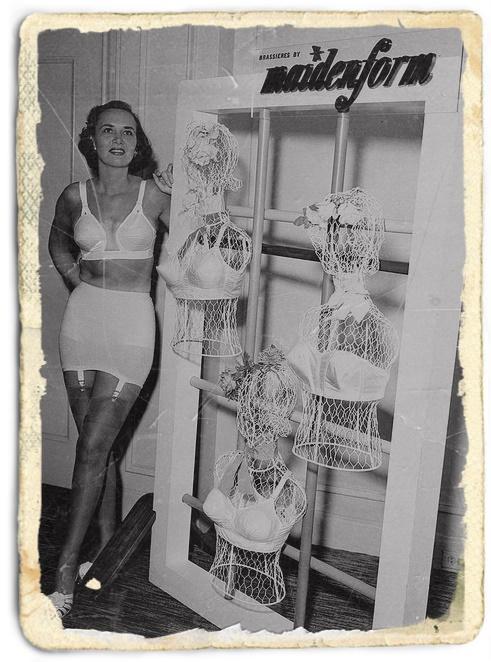
Following the Second World War, material availability, production and marketing, and demand for a greater variety of consumer goods, led to the demand of newer designs for bras. Manufacturers responded with new fabrics, colors, patterns, styles, padding and elasticity. One of the newer designs that emerged from this era was the “Bullet Bra.”
First introduced in 1949 by Maidenform, the bullet bra was a full-support bra with cups in the shape of a paraboloid with its axis perpendicular to the breast, and usually featured concentric circles or spirals of decorative stitching centered on the nipples. With the advent of the television set during the same time, television provided new promotional opportunities for the newly invented bullet bra, and played a huge part in the bras eventual popularity.
The bullet bra was quickly integrated into the look of Hollywood starlets, as it had become the bra of choice to wear under their tight sweaters. This was due to the fact that the bullet bra allowed women to add a cup size to their busts and provide an overly exaggerated pointed look to their breasts.
Hollywood fashion and glamour started to become a huge influence on women’s fashion choices in the 1950s. This new trend was due to Hollywood starlets such as Patti Page, Marilyn Monroe, and Lana Turner, who eventually became known as “Sweater Girls” due to the knit sweaters they would routinely wear over their bullet bras. This new fashion trend quickly became popular, not only with the Hollywood starlets, but with everyday women as well.
Though the Bullet bra remained hugely popular throughout the 1950s, the over-emphasized, pointed look of the bullet bra would eventually and dramatically decline in popularity in the 1960s.
The decline of the bullet bra’s popularity in the 1960s can partly be blamed on the new feminist philosophy that started taking root during the time, and which believed that bras were a sexist tool placed on women by men. During this time, in the 1960s, women started burning their bras and going bra-less. Also during this time, newer bra designs were also emerging as well. These newer designs included more lightweight, soft-cup bra designs. With both of these factors taking root in the 1960s, the bullet bra, along with its look, faded away.
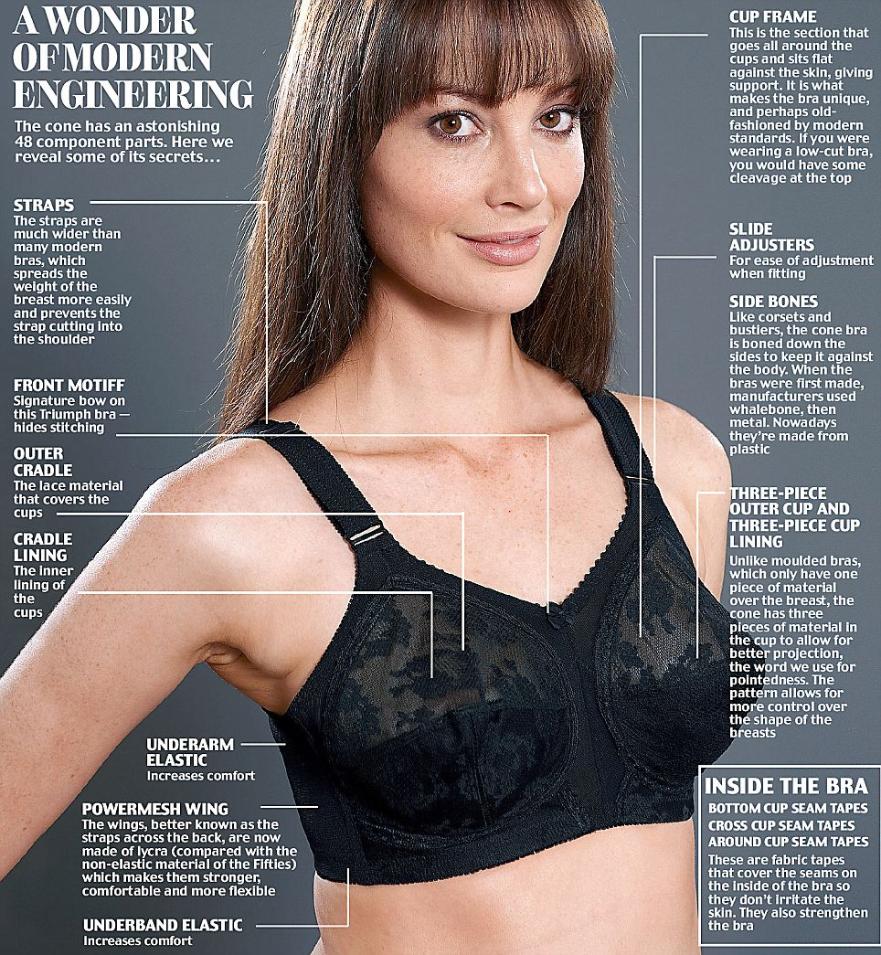
Though the bullet bra, or the overly exaggerated look it produced, has never made a comeback, their has been a resurgence of the look among entertainers, as well as within retro-fashion world. The bullet bra’s first major reintroduction came in 1990 when pop-singer, Madonna, wore a bullet bra designed by Jean Paul Gaultier during her Blonde Ambition Tour. Madona’s “new” look generated new interest, and controversy, in the bullet bra once again. Then, in 1999, vintage lingerie company, What Katie Did, was the first company to put the bullet bra back into production, and it has again grown in popularity with brands such as Marks and Spencer, Rigby and Peller and Naturana producing their own version of the bullet bra.
Though the Hollywood “Sweater Girls” who once were synonymous with the bullet bra and it’s look have long disappeared, other celebrities have since adopted the bullet bra look on occasion in modern days. These celebrities include America Ferrera, Amy Whinehouse, and Kate Perry. In 2017, Canadian filmmaker, Steve Cosmic, released am 80-minute documentary about the bullet bra titled Bullet Bra Sweater Girls. The documentary told a brief history of the bullet bra, and featured three young ladies who decided to wear bullet bras out in public to see how the garments made them look and feel.
See the vintage “bullet bra” look that was big in the ’50s
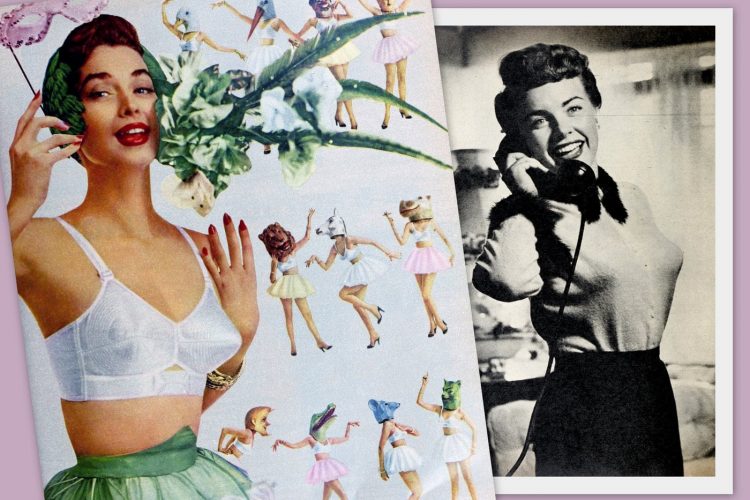
Abreast of trends, and history, too (1988)
Excerpted from a column by Robin Abcarian Detroit Free Press (Detroit, Michigan) May 26, 1988
Edward Maeder, curator of costumes and textiles at the Los Angeles County Museum of Art, has a unique talent: the “ability to date art within one year of its origins by the relationship of the breast to the body.”
“In a nutshell,” explained Maeder, “in 1798, the bosoms were under the chin. In 1803, they were in front of the shoulders. In 1903, they hung over your belt and were called the ‘monobosom,’ and in the ’20s, you weren’t permitted to have them at all!”
“The history of Western fashion is the rearrangement of that part of the female anatomy, which nature, unfortunately, has never been able to put in the place required by the mode.”
“In the ’30s, everyone thought they’d gone so far in the ’20s that the next step was total nudity,” he said. “In fact, that’s what was achieved!”
I said I hadn’t ever heard about that. “Well, bias-cut fabric is like total nudity, because women in those gowns couldn’t wear underwear — it would cause a line,” said Maeder.
Unless you were an adolescent then, the ’40s were a boring time for breasts, but, ahhhh, the ’50s, were much better. “It was the antithesis of the ’20s,” said Maeder.
“Everything was lifted and separated. We’d achieved the atomic bomb, better living through chemistry, and all this naive optimism produces very flamboyant dress, and nothing could be more flamboyant than the ’50s breast. In bullet bras, they were lethal weapons.”
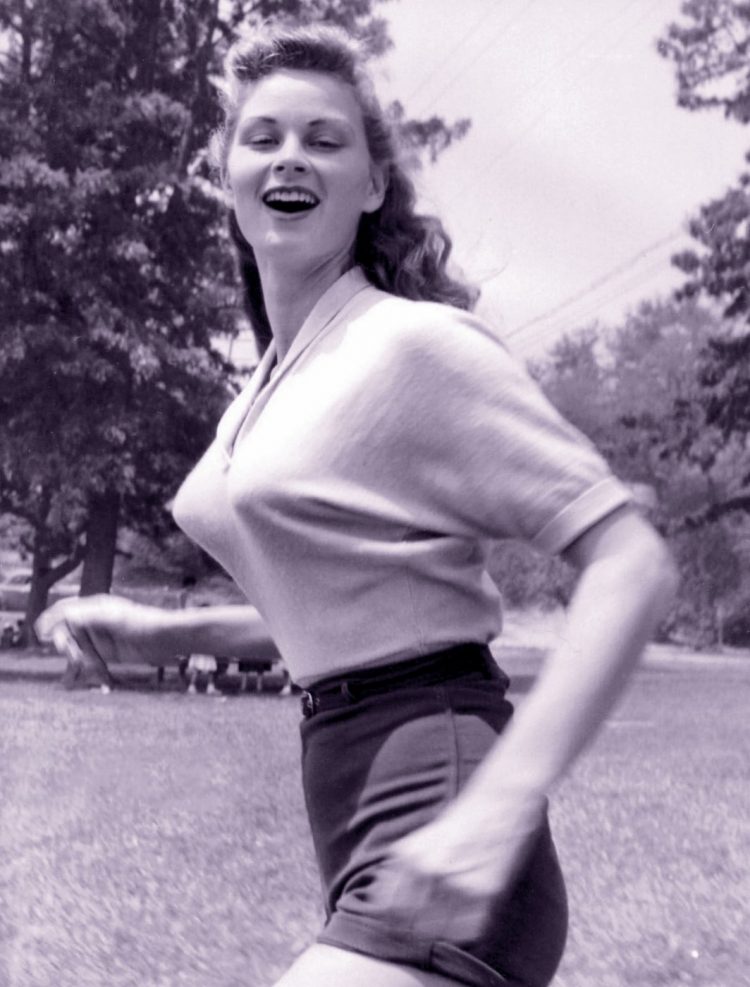
Busting through TV’s bra barrier — and the underwear-related words that were too improper for television
By Bob Bernstein – Billboard (Sep 29, 1956)
The heavy saturation campaign of International Latex is the strongest entry to date of brassiere and girdle advertisers into television. But it doesn’t mean that stations, networks and citizen groups feel any more comfortable about putting such products on the home screen.
Previous excursions by Exquisite Form, Sarong, Flexes, Maidenform, Playtex, Question Mark and other brands proved short and unsatisfactory. The breaking of the bra barrier in the fall of 1950 brought many companies into TV, but lose ratings and continued head-shaking hurried them out.

The new International Latex schedule, launched August 1, calls for 70 spot commercials a week, 52 weeks a year for five years, in each of the nation’s 100 major market areas. The company expects to triple its business within two years through these spot films, which have been created with both eyes on the taboo lists.
Topper method
Playtex bras and girdles, leading items for International Latex, are now displayed via a technique created by Don McClure, the firm’s director of film. McClure has dubbed it the “Topper” method, because it utilizes the vanish-reappear technique made famous by the “Topper” films.
They used to call it ectoplasm. McClure avoids the danger zone of showing real live females wearing lingeries before your very eyes. He does this by filming his girls fully dressed and then causing them to fade away while their undies remain floating through the scenery.
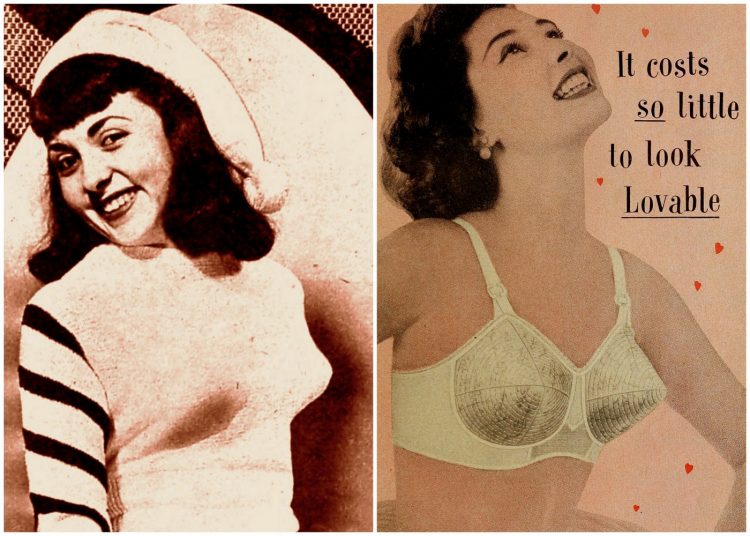
Of the three existing ways to accomplish this, rotoscope, rear projection and lens cutouts, he chose the second as being most original and least costly.
Despite the fact that protests have been negligible, International Latex doesn’t feel that the breach between stations and sponsors has decreased in the torso field.
An executive of another bra-and-girdle company that tried TV briefly sums it up this way: “The networks underestimate the age level of the home viewers. Only after women’s products considered even more shocking arrive in force on TV will bras be accepted as decent enough for Mom and Dad to look at together.”
Until September, 1954, brassieres were considered too intimate to be advertised on network radio or TV in Class A time. ABC-TV did carry such commercials twice before, for Exquisite Form in 1930 late at night and for Maidenform in 1951, Saturdays at noon.
Both campaigns were on sharply limited networks and had numerous rejections from individual stations, in spite of agency efforts to woo them with personal visits in 42 states.
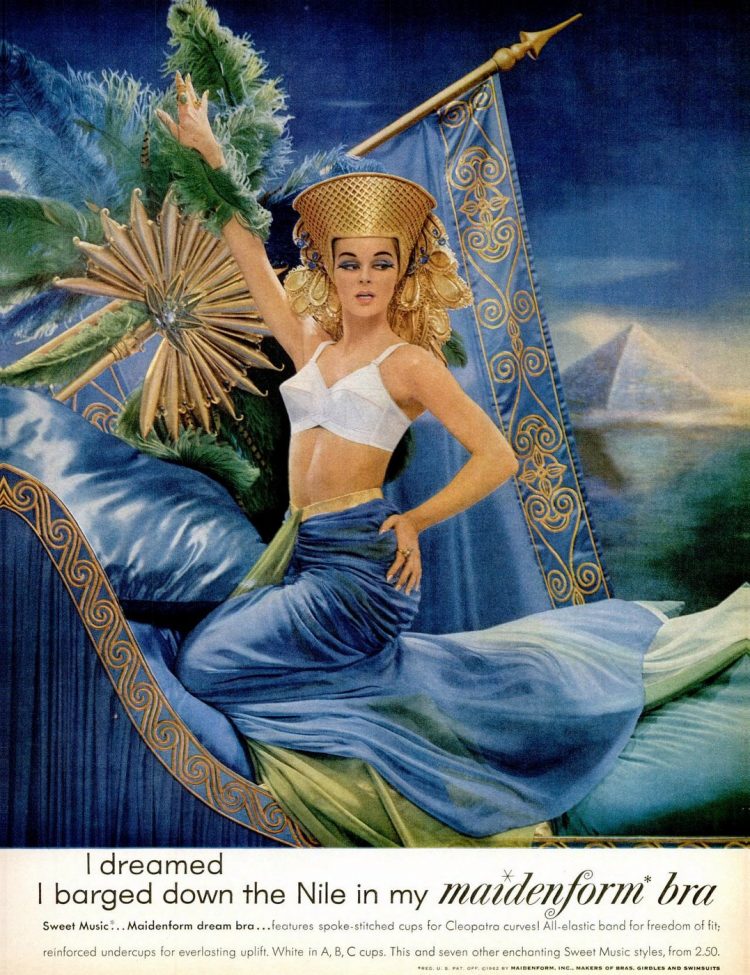
And the commercials, which were live, covered the models with so many veils and layers of netting that the product could hardly be seen.
Exquisite Form was discouraged by network restrictions, which prevented the girls from moving even one inch to demonstrate the virtues of the product, and by thousands of angry letters labeling a girl in a sweater as indecent. Its sponsorship of “The Robbins Nest” halted after 13 weeks.
Firm depressed
Maidenform was equally depressed. Its one-minute dream sequences on “The Faith Baldwin Theater of Romance” were eventually okayed by 51 stations, but the sales department found that women didn’t want to buy bras worn by frozen statues.
ALSO SEE Women: Do you have the ideal figure? Here’s what “they” thought in 1950

Sarong tied in with Gimbel’s department store, New York, in 1954 for a brief series if TV spots using an early form of the ectoplasm technique.
“We’ll be back in TV when the networks relax their hidebound rules,” says Bob Hall, vice-president in charge of advertising for Sarong, Inc. Each station, network, religious group, fraternal organization and viewer has a special set of do’s and don’ts, making bra-and-girdle storyboards among the most difficult compositions of any creative field.
Continuity departments of the networks now favor a case-by-case coverage of all commercials, hot the detailed lists of taboos still exist.

Word taboos
The number of words whose use is forbidden, for example, has increased rather than diminished.
Among them are pants, bust, chest, lift, uplift. cup, flat, round, separated, padded, firm concave, con-vex, pelvic, hippy, ride up, plunge down, spread and cling to as well as more obvious ones. This makes it pretty difficult for a sponsor to get his message across.
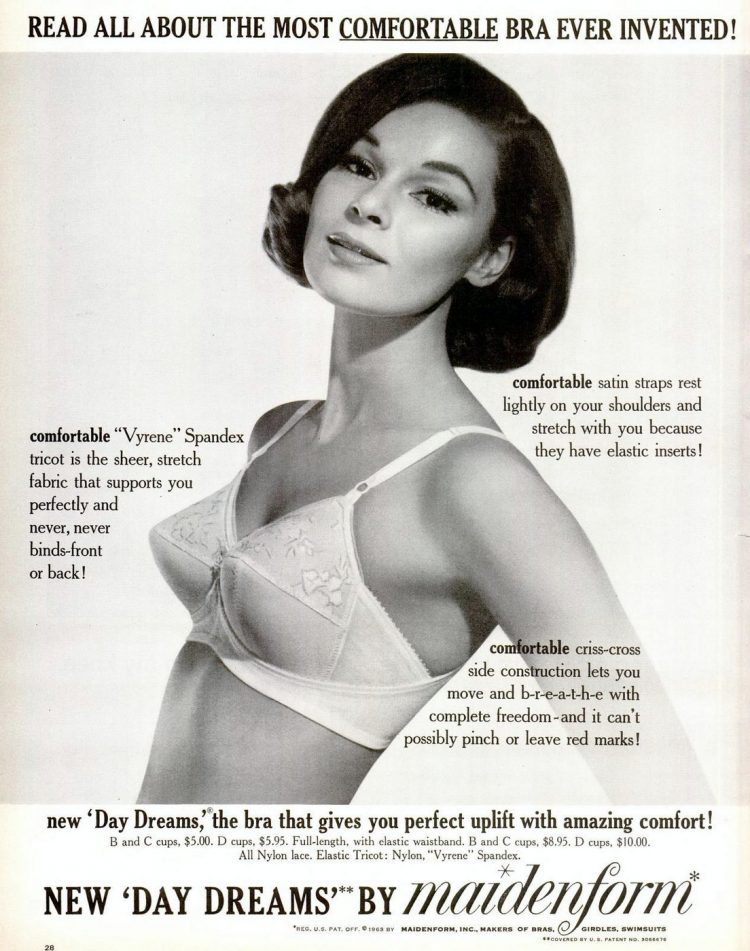
Some companies keep coming back for more, however. Exquisite Form retreated to magazines after “The Robbins Nest,” but returned to TV late in 1954 on “Stop the Music,” using three ballerinas and an animated sprite at a cost of $25,000 per two minutes of commercial.
After a heroic 39-week stint, Exquisite Form again retired to the printed word, which draws no letters of complaint. Now, after some tests in Washington, it is back on ABC-TV’s “Afternoon Film Festival” for 13 weeks with Janet Tyler (now ABC weather girl) and a dummy. The dummy wears the bras.
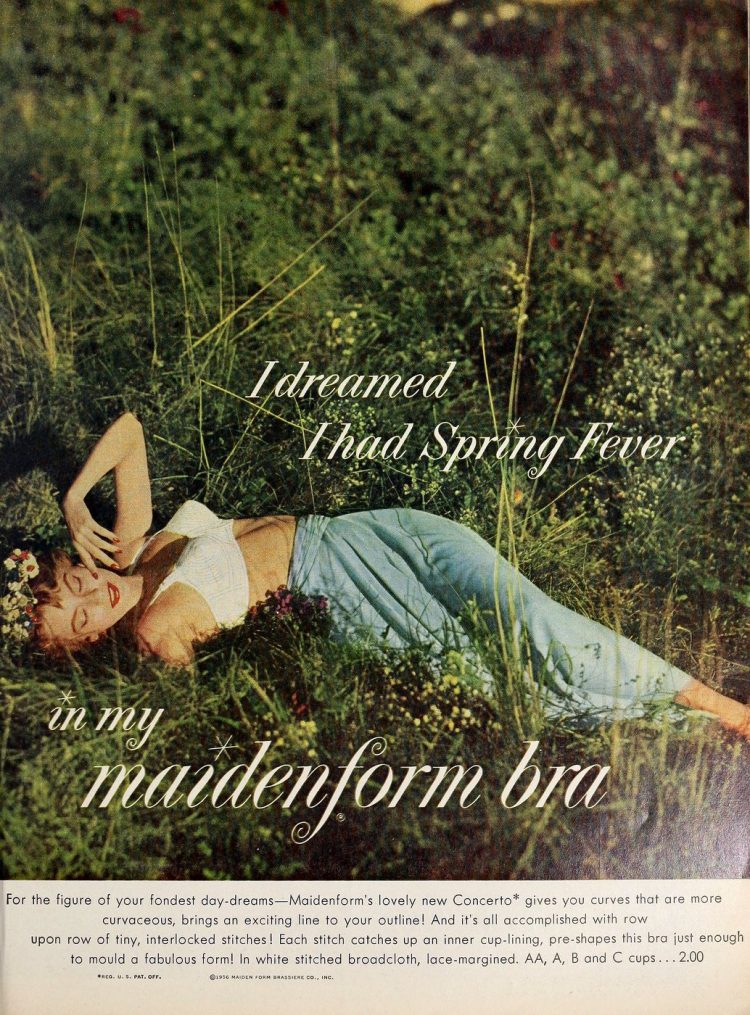
The two solutions of Playtex and Exquisite Form, today’s only two national TV advertisers in the lingerie industry, represent thousands of hours of trial and error approaches to the problem of over-coming TV’s diffidence, which takes the word “unmentionables” be just a supplementary means of communications.
As for station managers, as one undies king put it, “They are poor little sheep who have lost their way, bra, bra, bra.”
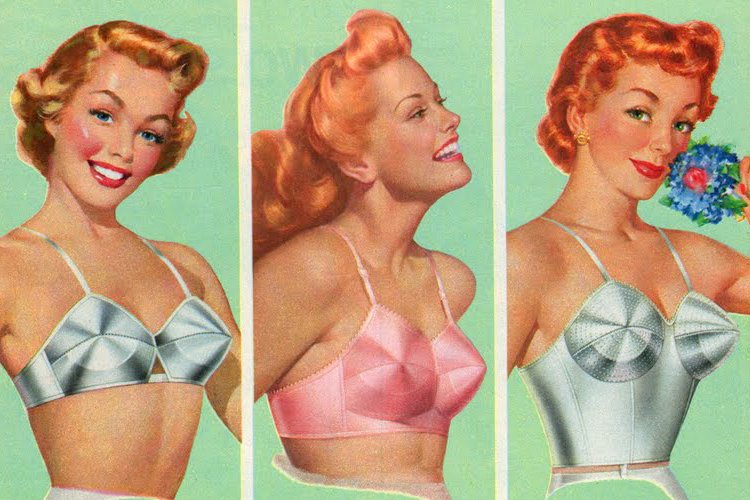
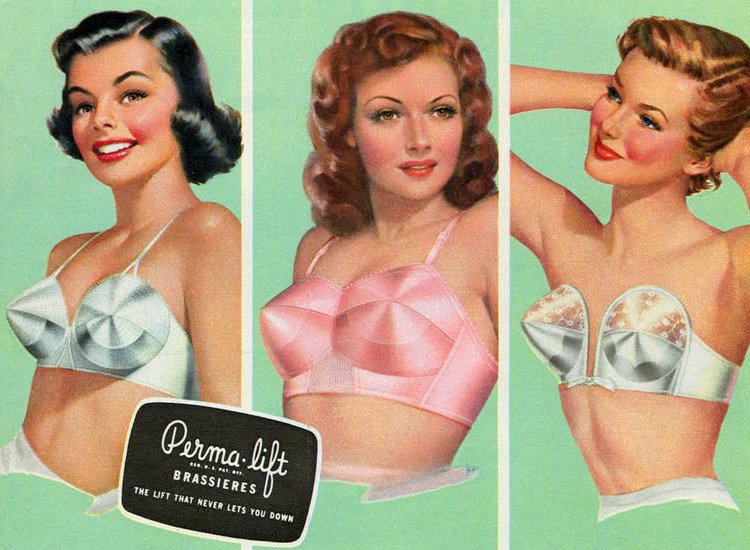
Marilyn Monroe and Jayne Mansfield in pointy vintage bras
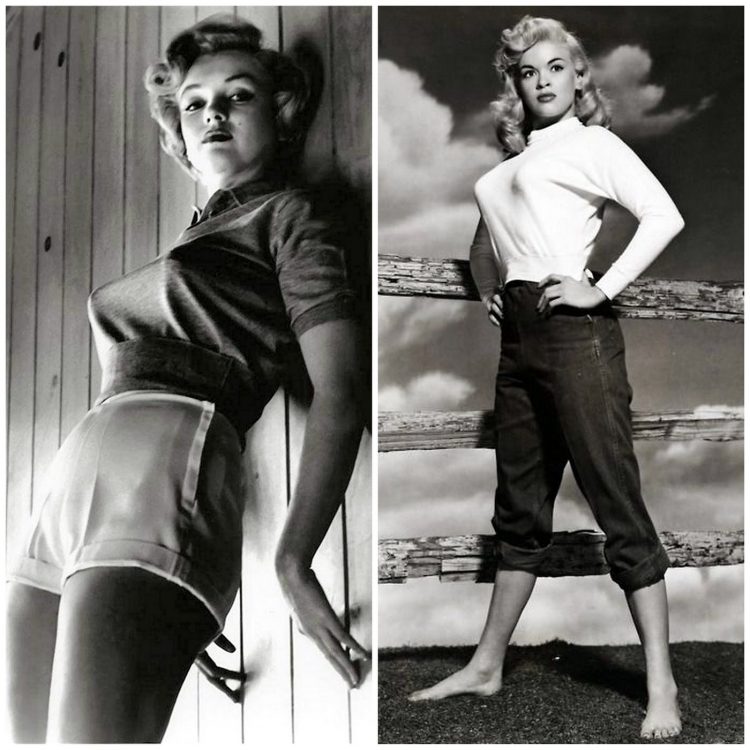
More pointy vintage bras & bullet bras from around the ’50s
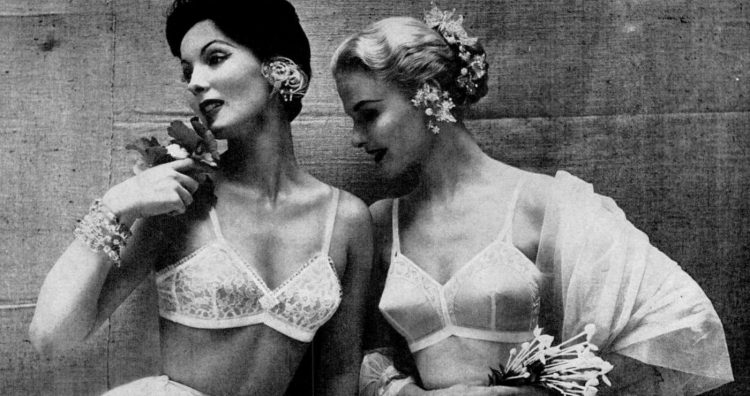
Perma-Lift bras: “The lift that never lets you down”

Party secrets: Fashionable bra from the ’50s
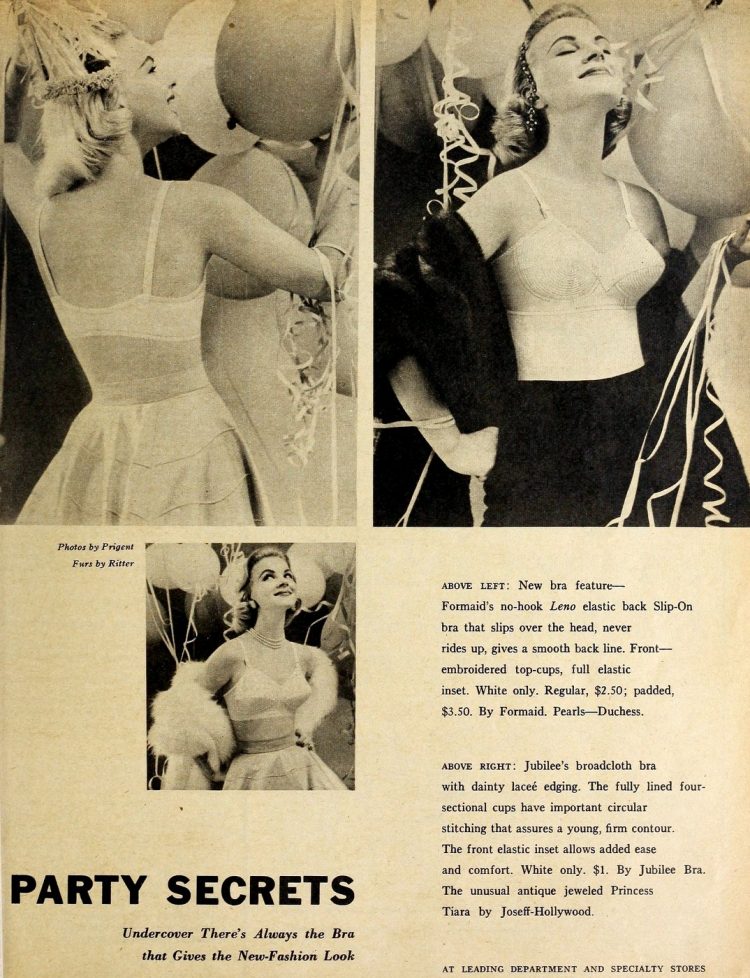
“I dreamed I opened the World Series in my Maidenform bra” (1952)
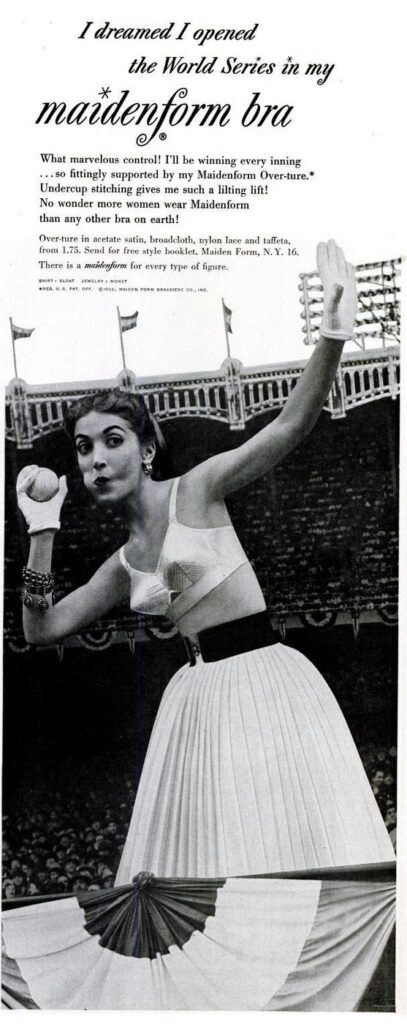
Model Diana Dors in vintage sweater bra


Woman in bra and satiny dress
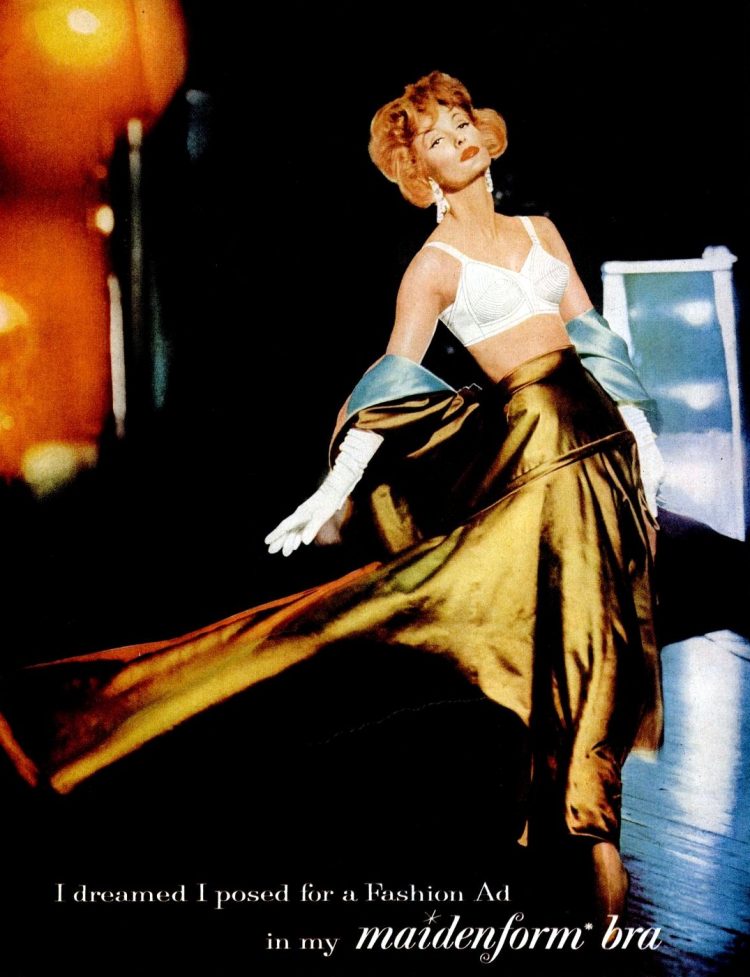
Yours, for rounded beauty in Lobable’s Ringlet bra
See how Ringlet lifts, rounds, firms the bustline — thanks to the thousands of tiny stitches that spiral ’round the cups.

Driving them wild in a Maidenform bra

With this sweater bra on, men have to wait in line to get her phone number
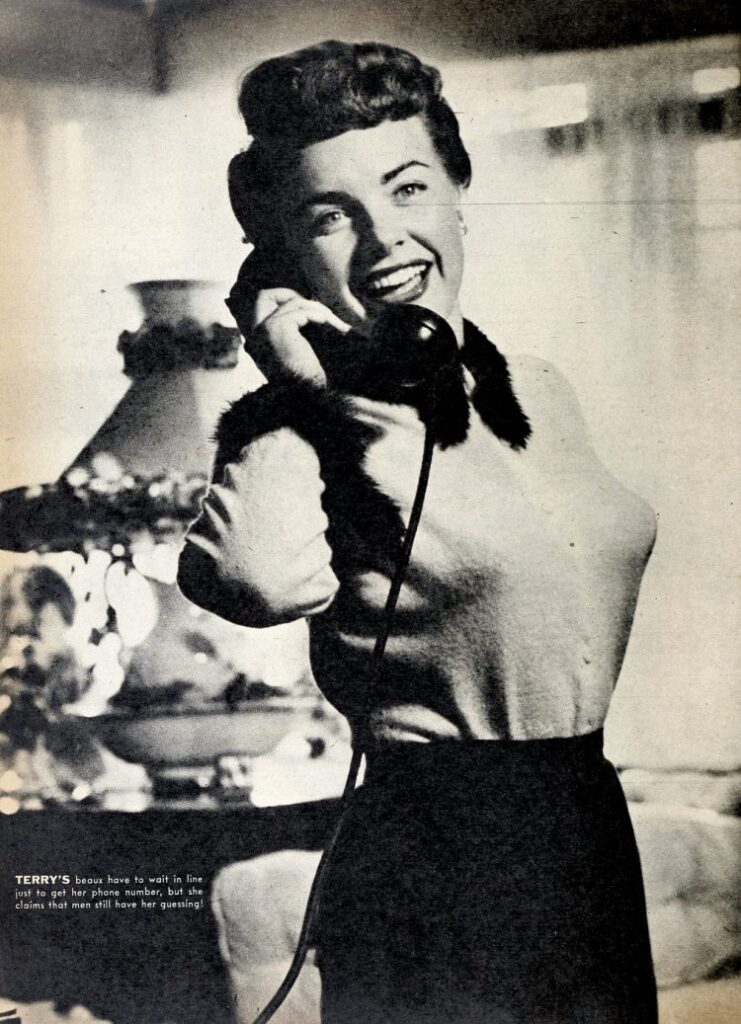
Dreamed she was a heavenly body (1950s)
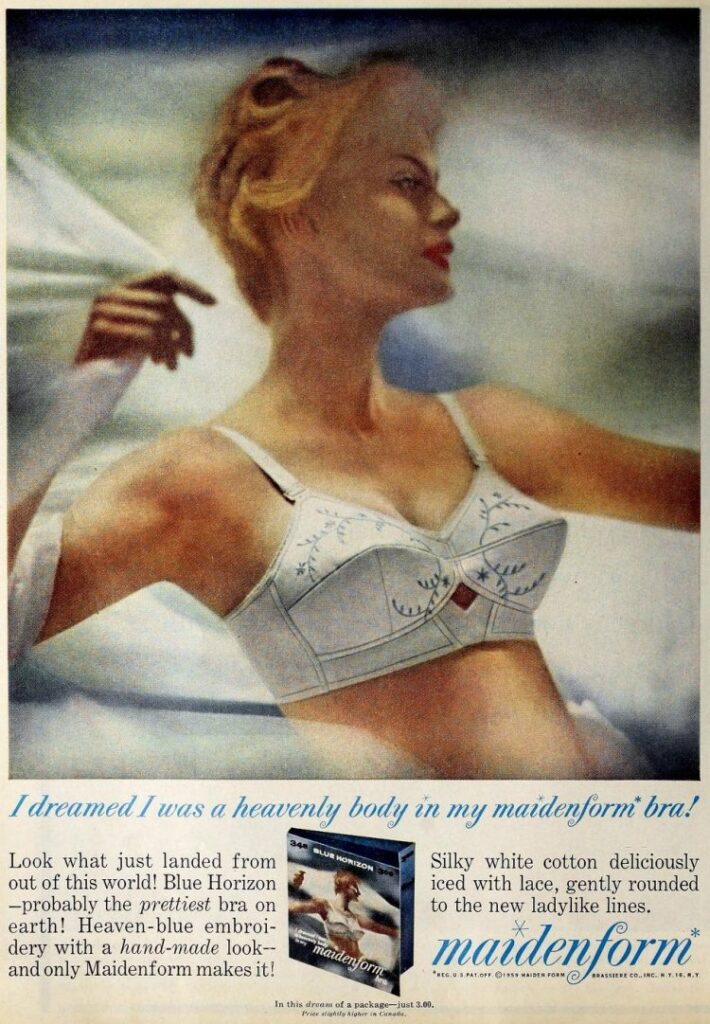
Actress Ann-Margret in a sweater bra
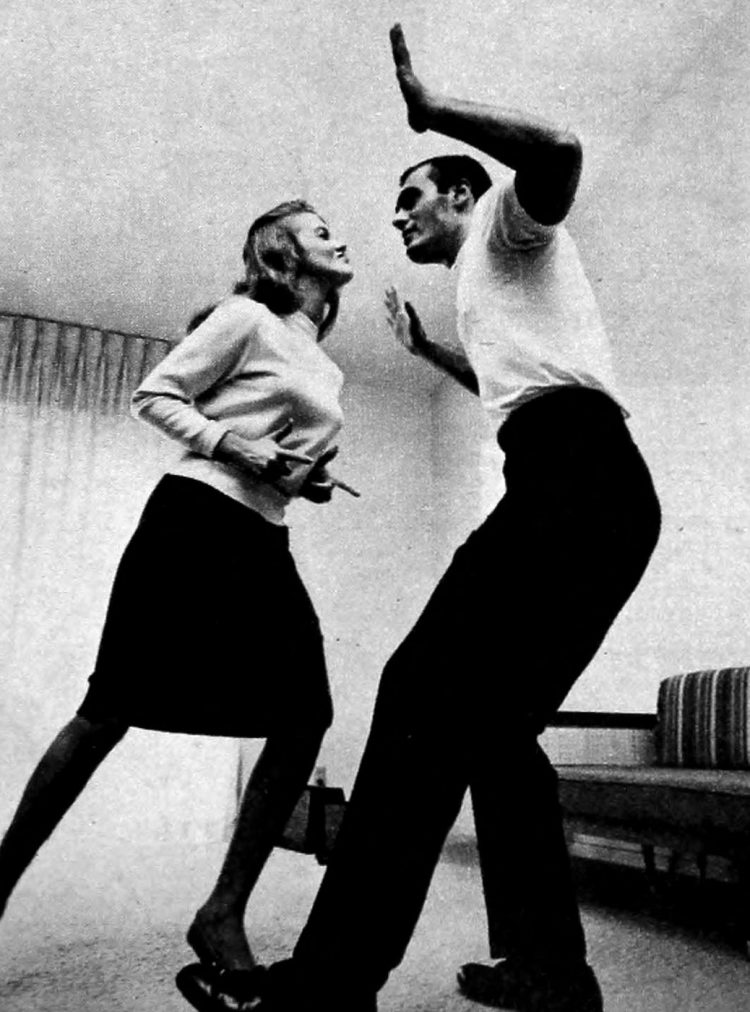
Vintage Chansonette bra

Strapless bra has wire over bosom (1946)
Alene, largest wired-bra manufacturer, makes three shapes: sweater, cup-shaped and accentuated, or Ubangi.

Strapless wired sports bra, ’40s-style
“Even in action, the bra defies force of gravity.”
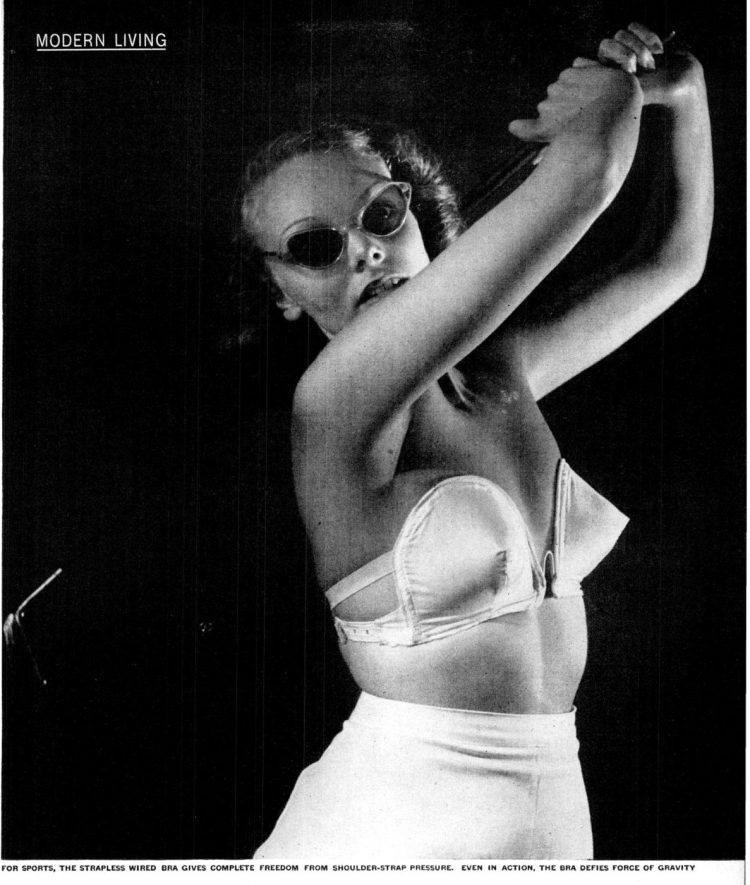
Social butterfly – Vintage Maidenform bras (1950s)
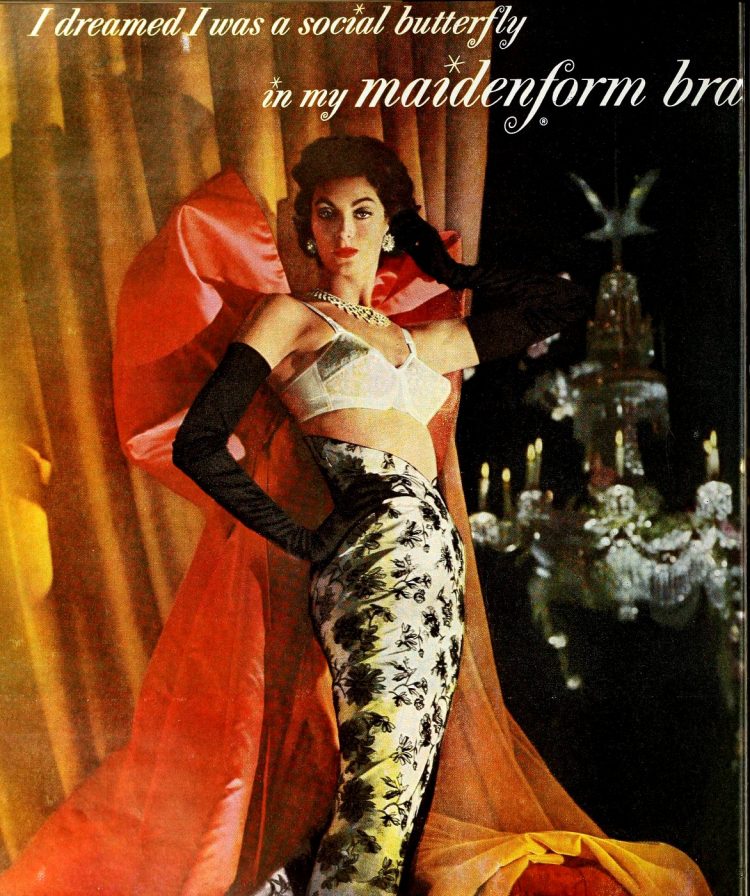
Masquerade: vintage bras
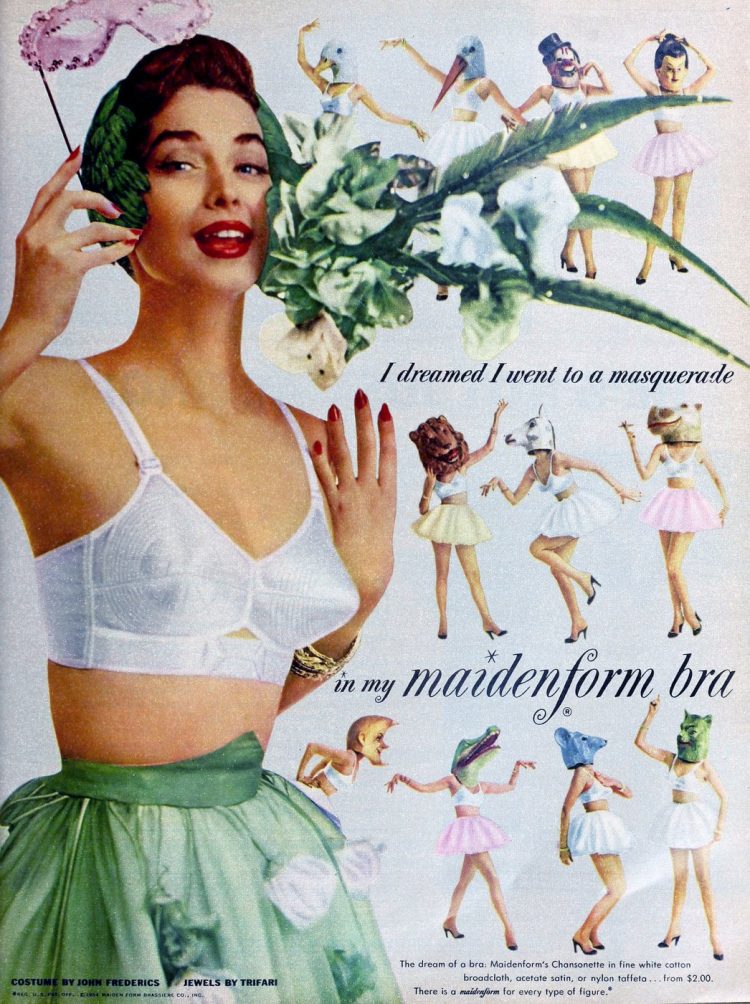
Concertina bra with “Action frame” cups (1964)

These Ridiculously Pointed “Bullet Bras” Were Trendy Back In The 50s & Honestly, We Don’t Know Why!
by Diksha Varma | Scoop Whoop
I remember as a child, I was particularly intrigued by our filmy heroines and their super tight clothes and weird torsos. And don’t even get me started on those conical bras. I mean they could poke someone’s eyes out. Was that fashion? I still find its clones in the market and I wonder how women breathe wearing those?
Fashion trends have changed tremendously over the last few decades and will continue to. While some trends have stuck around, some have made a come back and there are some we can’t hope but feel a little nauseated by.
“Bullet Bras” were a trend that became the rage in the 1940s and 1950s and were also at that time considered to be a great development in lingerie design. Yes, bizarre as it sounds !
The first pointy bra was called the Chansonette bra, in the early 1940s. The design was then adorned by several leading ladies and pin-up girls. The shape was “aggressive” and meant to give that perfect “silhouette.”
In fact, a lot of leading ladies in Bollywood were also seen wearing these and no one seemed to think of it as an absurd trend.
Bullet Bra is a full-support bra with cups in the shape of a paraboloid with its axis perpendicular to the breast.
The “Bullet Bra” made a comeback when the popular singer Madonna wore one in the ’80s.
It in fact made a comeback of sorts at Stella Mc Cartney’s Fall 2017 show – an ode to the provocative 1950s undergarment made iconic by the Madonnas and Marilyn Monroes of the world.
For many the bra was symbolic of the changing time and celebrated the female form. But detractors found it more objectifying as it lay too much emphasis on the chest of a woman.
We think, bullet bra or bare-chested, the idea is to be comfortable in what one is wearing and feeling confident. Flaunt your assets if you may, or don’t, the choice is yours.
The Story Behind The Pointy “Bullet Bra” Trend Of The 1950s
by Manon Baeza, Konbini
Remember the pointy corset Jean Paul Gaultier created for Madonna? In the fashion world, that’s what we call a “bullet bra.” The thing is, Jean Paul Gaultier didn’t even invent the strange contraption.
To learn more about the origins of the bullet bra, we have to rewind to the 1950s, when it was in perfectly good taste to walk around with giant triangle boobs.
At the time, pointy bras were the hottest trend. A new circular sewing technique (called the “whirlpool circle stitch”) gave your bosoms that sexy “missile” look that went perfectly with the skin-tight sweaters of the period. The tight sweater-bullet bra pairing was then dubbed the “pointy look.”
The bras, which gave the wearer an especially voluptuous chest, were quickly snapped up by big 1950s stars like Patti Page, Elizabeth Taylor, Marilyn Monroe and Brigitte Bardot. However, as Dangerous Minds tells us, the trend became obsolete in the 1960s, particularly with the rise of the women’s lib movement.
A caricature of femininity
After the lean years of World War II, women were getting their curves back in the prosperity of the post-war boom. This happened in parallel with the arrival of Christian Dior’s “New Look” which had an impact on style throughout the world.
When the trend arrived in 1947, the Dior revolution touted an “hourglass” figure. The New Look was characterized by round hips, belted jackets, prominent breasts, and an ultra-cinched waist due to the return of the corset (much to the dismay of Coco Chanel, who fought to liberate women from the torture device).
At the time, women were reclaiming their bodies through the use of lingerie. Thus, girdles, waspies and waist-cinchers made their way back into closets, making it possible for women to embody the idealized Dior silhouette.
None of this was comfortable, of course, but society seemed to be trying to recapture some kind of pre-war femininity, which gave free reign to the most eccentric of fantasies.
The new trend couldn’t have been further from the fashion of the 1920s, when women went to the other extreme of wearing bras that would flatten their chests.
Forty years later, the artificially exaggerated curves of the bullet bra were picked up again by Jean Paul Gaultier, who created the iconic cone bra for Madonna’s Blond Ambition Tour in 1990.
After the current unisex trend, is there any chance of the bullet bra making a comeback? One of Stella McCartney’s recent collections leads us to believe it could happen! We’ll have to wait and see.
- Instagram: https://www.instagram.com/p/BV_A1heli7U
- Instagram: https://www.instagram.com/p/BV_AyfVFaK4
- Instagram: https://www.instagram.com/p/BV_Ai9SlbhE
- Instagram: https://www.instagram.com/p/BWFNeIFhlIz